Dandie Dinmont Terrier
 Dandie Dinmont Terrier
Dandie Dinmont Terrier
In the 1700's, what are now known as the Bedlington and Dandie Dinmont Terrier were the same breed. Developing for different purposes on both sides of the English-Scottish border, they had different leg lengths for work on top of and underneath the ground respectively! By 1874, they had become two of the oldest show breeds that appeared in the First English Stud Book. Today, they still have significant similarities of general body shape, coat colour and silky topknots.
History of the Dandie Dinmont
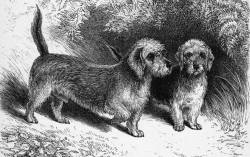 Dandie Dinmonts 1872
Dandie Dinmonts 1872
A race of short legged terriers answering the description of Dandie Dinmont was kept by the farmers on the Scottish side of the Border Region before the end of the 1700's. These terriers were sufficiently hardy to hunt any animal from the weasel family which includes not only stoats and polecats, but also otters and badgers. From these earliest times the Dandie was required to have 'a long, low weaselly body', words that remain in the breed standard to this day.
How the original Dandie came to have short legs is 'lost in the mists of obscurity'. As Rawdon Lee also wrote in 1894:
 Mustard and Pepper Dandie Dinmonts c 1900
Mustard and Pepper Dandie Dinmonts c 1900
.. it was well known that Border farmers and others kept a hardy race of short-legged terriers, answering to the description of the Dandie Dinmont, even before the end of the 1700's. They assisted the hounds to kill otters, and were hardy enough to destroy foxes in their holes... notwithstanding their short legs and long bodies, were fairly active and as hard as nails[1].
Although the original Dandie was smaller than the modern one, perhaps in an endeavour to obtain greater bone as well as larger heads with stronger jaws, heavier bodies were also produced. So the short legs became entrenched in the breed, as did the long strong body shaped like the weasel he was bred to hunt.
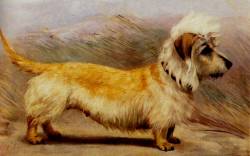 Ch. Dandie Dinmont 1906
Ch. Dandie Dinmont 1906
It is recorded that around 1800, a farmer named James Davidson was given a pair of splendid workers that were short on the leg, large bodied, and had large heads with pendant ears. James Davidson, a keen sportsman who owned ten or twelve couples of these terriers, was typical of his time. So when the celebrated novelist Sir Walter Scott published the book 'Guy Mannering' in 1814, he invented the name Dandie Dinmont which seemed to suit typical characters like James Davidson. Names of his dogs included 'Old Pepper' and 'Old Mustard', 'Young Pepper' and 'Young Mustard' and 'Little Pepper' and 'Little Mustard'. Hence the names of the permissible colours of pepper and mustard which remain in the breed standard today.
The Dandie Dinmont becomes a Pure Breed
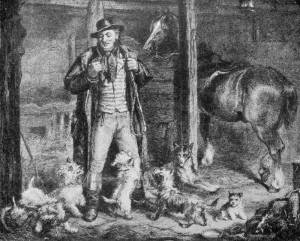 Dandie Dinmont and his terriers
Dandie Dinmont and his terriers
The book, 'Guy Mannering' sparked such demand for the Dandie Dinmont, that considerable numbers were bred. This surging popularity escalated when dog shows were first beginning to become popular. With this came controversies which sparked the formation of the Dandie Dinmont Club in 1876. They wrote an extremely detailed Breed Standard to counteract some of the exaggerations which had begun creeping into the breed. These included excessive topknots, bodies being too stiff and cobby to retain their flexibility and bowed front legs.
After 100 years of existence, after it was emphasized that the Dandie Dinmont should remain a sound, working terrier, a Dandie won Best Terrier Exhibit at Crufts Dog Show (UK) 1902 and again 1906[3].
History of Dandie Dinmont Terriers in Australia
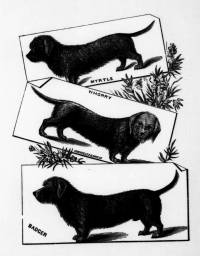 Dandies (Australia) c 1890
Dandies (Australia) c 1890
In Australia, early importations of Dandie Dinmonts into Victoria from 1890 - 1903 are recorded in "The Dog in Australasia"[4]. Additionally, the attached picture was published in 'The Australian Dog News' around 1890. So, it is assumed by the listing of imported dogs that these were brought here by the Mr Clark named on the middle picture. But these early importations must have died out because Dandies are named among the breeds listed in Tyzacks Annual as not being here in 1911[2]. Additionally, we could not find any records of Dandies here for the next 60 years.
In the 1970's Don and Mary MacCaul began importing and breeding Dandies under the Marydon prefix. They rekindled interest in the breed and, in 1990 Dr Emma Greenway became involved. She has imported and bred some excellent specimens under the Jollygaze prefix which have held their own on the all-breeds and Specialist platforms both here and overseas.
Similarities between the Bedlington and Dandie Dinmont Terriers
Another way of looking at it is by their similarities and differences. These are:
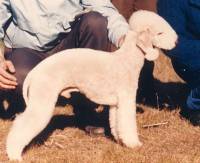 Bedlington Terrier (Liver)
Bedlington Terrier (Liver)
Topknot - Profuse and silky
Mouth - Normal scissors bite with exceptionally large teeth
Ears - Thin and lowset on the head and dropped, hanging close to the cheek with a tuft of hair at the end
Coat Texture - Double coat with soft undercoat which feels like lint, but is actually a mixture of hard hairs coming through a soft undercoat
Topline - An arch over the loin with the Dandie also having a slight downward curve at the shoulders
Ribcage - Deep, despite the shape being so different
Hindlegs - Appearing to be longer than their forelegs
Tail - Thick at the root and tapering to a point and gracefully curved or shaped like a scimitar.
Differences between the Bedlington and Dandie Dinmont Terriers
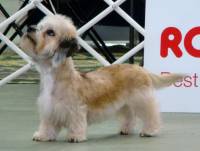 Dandie Dinmont Terrier
Dandie Dinmont Terrier
Height - the main differences between these two breeds relate their difference in height at shoulder because of their function. The Bedlingtons are long legged terriers which mainly coursed rabbit and hare above ground while the Dandies are short legged terriers that mainly followed vermin especially weasels underground. So their height corresponds to the purpose for which they were developed. The Bedlington should have a height of around 41 cms (16 inches) with a weight of 8 - 10 kilos (18 - 23 pounds) while the Dandie has a height specified from 20-28cms (8-11 ins) at withers.
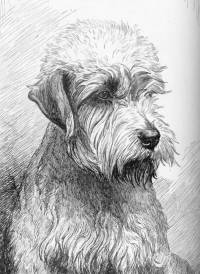 Dandie Dinmont Terrier
Dandie Dinmont Terrier
But interestingly while the weight of the Dandie is not specified, the length of the Dandie's body is! So similar to the Skye Terrier that was also developed for underground work, the Breed Standard dictates the measurement from withers to root of tail not be more than twice his height, but preferably 2.5-5cm (1" to 2") less. So the size specifications alone reflect the purpose of the Bedlington and Dandie. Additionally while the Bedlington has the build of being capable of galloping at high speeds, the Dandie has the build that enables him to slither through underground tunnels.
The breed standards also differ in the following respects:
Head - The Bedlington has a narrow but deep skull with no stop. The Dandie has a large head with extraordinary cheek muscles, with a measurement from inner corner of eye being the same as from ear to ear and a ratio of muzzle to skull being three as to five. The top of the Dandie's muzzle also has a triangular bare patch about an inch wide pointing backwards towards the eyes.
Coat Colour - The Bedlington can be blue, liver or sandy with or without tan markings, obvious when the dog is young. But when adult can look almost white especially livers and sandies. But as they become older and for example, when a bitch has a season and/or a litter, a liver's body can look medium brown with a lighter coloured head and legs. This usually fades again until the next season. In the same way, a blue can become dark whilst also retaining the lighter coloured head and legs. Males can also gradually change with age. This colour is not just the guard hairs, even the soft undercoat look dark on their body.
On the other hand, the Dandie's colour of mustard or pepper at the end of each hair is much more obvious at all ages and gives a look of lying in pencils.
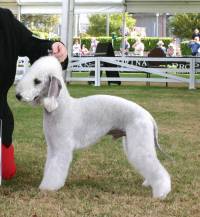 Bedlington Terrier (Blue)
Bedlington Terrier (Blue)
Nose colour - The Bedlington has a brown nose if it is liver or sandy and only the blue or blue and tan has a black nose. But the Dandie's nose must always be black.
Neck - The Bedlington's neck is long and springs up from the shoulders whereby the Dandie's neck is set into its shoulders and therefore carried in a more forward, rather than an upright position.
Shape of Ribcage - the Bedlington has flat ribs whereby the Dandie's ribs are round and drop well between the forelegs.
Front - The Bedlington's forelegs are straight but wider apart at the chest than at the feet. When the dog is standing facing you, four fingers should be able to fit between the forelegs, but this should reduce at the feet to three fingers in width. This unique feature allows the dog to pivot more easily when required to gallop at high speeds. Although the Bedlington is a coursing dog that worked on top of the ground, he still had to be capable of digging into and so entering the dens and therefore has a terrier front.
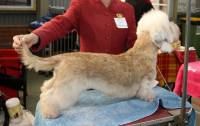 Dandie Dinmont Terrier
Dandie Dinmont Terrier
Because the Dandie's ribs are round and the chest comes well down between the short well boned forelegs, the forearms although not bandy, must follow the line of the chest. This can cause the feet to point slightly outwards when the dog is standing. In other words, they have slightly bowed front legs (crooked front). Additionally, when the dog is digging its way through the dens of the weasels it was bred to hunt, it shifts the dirt to the side of his body so the chest followed by the rest of the dog, can slither through the hole.
Feet - The Bedlington has long hare feet and long pasterns typical of a coursing breed while the Dandie has round well-padded feet typical of a digging terrier.
Gait - The Bedlington has such power and flexibility in its hindquarters, it can gallop at high speeds at a double suspension gallop. So at a trot its action is described as 'mincing' light and springy at slow paces and with a slight roll at full stride. The Dandie has a typical fluid free stride.
BREAKING NEWS.
We have now published a unique Terrier book 'Terriers Unveiled' Available at our sister site: https://rangeairevision.com/terriers-unveiled/
References and Further Reading
[1] Rawdon B. Lee, "Modern Dogs" of Great Britain and Ireland (Third Edition) London:Horace Cox, "Field" Office, Windsor House, Bream's Buildings, E.C. 1903 Dandie Dinmont Chapter X11 Pages 313 - 325
[2] T.W.Tyzack and C.S. Turner "Tyzack's Annual" published by the Victorian Poultry and Kennel Club 1912, printed by Bellmaine Bros., Printers 66 - 70 Flinders Lane Melbourne Australia P.93 (Dandie Dinmonts)
[3] E.W.H.Blagg 'The Dandie Dinmont Terrier' Cassell's New Book of the Dog' by Robert Leighton assisted by eminent authorities on the various breeds Published by The Waverley Book Co Ltd Vol 111, Chapter XLII Pages 398 - 404